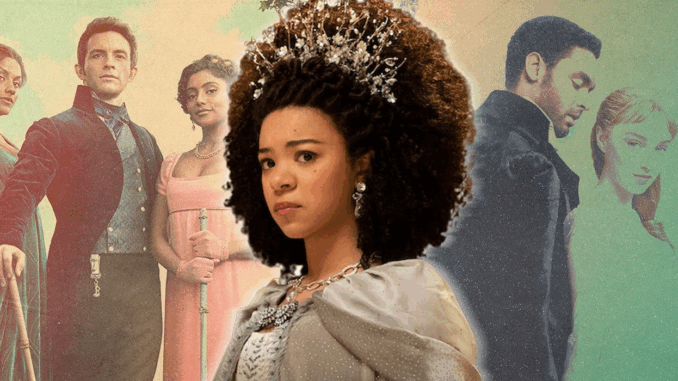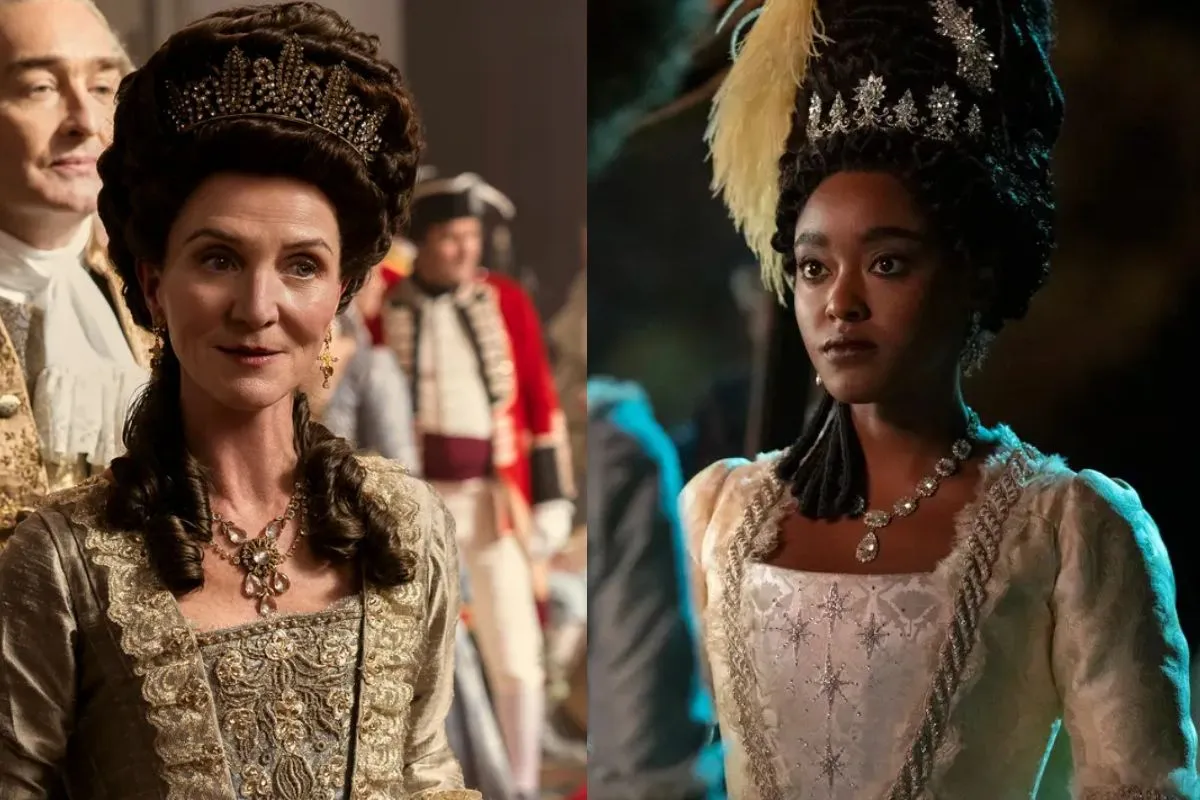
It’s nearly blasphemous to say it out loud, but not everyone feels that Queen Charlotte is the shining crown jewel of the Bridgerton universe. For many, the series was everything they hoped for, emotionally gripping, beautiful performances, and visually breathtaking. The praise has been thunderous and, to some extent, deserved.
Yet, beneath all that glitz lies a series that, while impressive, stumbles in ways that make it hard to wholeheartedly crown it as the best installment. The truth is, Queen Charlotte could have been iconic. Instead, it sometimes feels like a royal melodrama that lost sight of what made Bridgerton so compelling in the first place: its lore, its pacing, and its perfect balance between scandal and heart.
How Queen Charlotte: A Bridgerton Story let emotion overpower its plot…
Queen Charlotte set out with grand ambitions—to tell a sweeping love story not just marked by romance, but by duty, sorrow, and sacrifice. On many emotional levels, it succeeded. The ache that underlines Charlotte and George’s relationship is both palpable and haunting, offering a raw and vulnerable portrayal of what it means to love someone deeply while being powerless to save them from their own mind. Watching Charlotte navigate the gilded cage of monarchy, burdened by expectations and stripped of choice, is genuinely moving. Her pain is not performative; it feels lived-in, layered, and real.
Charlotte’s emotional arc is meant to be the backbone of the series, and in many ways it is. But what’s missing is a sense of active engagement—of her taking decisive steps to shape her own story. We see her drowning in emotion, yes, but rarely do we see her channeling that emotion into action. There’s a difference between suffering and growth, and while Queen Charlotte shows the former in abundance, the latter is often left underexplored. The audience is given access to Charlotte’s interior world, but not always her agency.
The show’s treatment of side characters adds to this sense of underdevelopment. Lady Danbury, in particular, stands out as a missed opportunity. In Bridgerton, she is presented as a fierce, witty, passionate woman who has clearly lived a full and complex life. Naturally, fans expected her backstory to reflect that same richness—a portrait of a woman who loved deeply, fought boldly, and carved out space for herself in a world that offered her none. Instead, what viewers received was a storyline that hinted at depth but never fully delivered. Her romance with Lord Ledger, for instance, is introduced with promise but evaporates quickly, never given the time to blossom or resonate. What could have been a powerful exploration of forbidden love becomes a subplot that feels rushed and, ultimately, inconsequential.
Her political maneuverings with Princess Augusta also fall short of their dramatic potential. Early scenes suggest a brewing battle of wits and influence—two powerful women negotiating power in a rigid, patriarchal system. But instead of escalating into a gripping power struggle, the storyline fizzles out. There are conversations, yes, and small victories, but the stakes never feel as high as they should. For a character as sharp and strategic as Danbury, the show barely scratches the surface of what could’ve been a thrilling exploration of ambition and agency.
In the end, Queen Charlotte leans heavily into mood and emotion, and while that choice yields some breathtaking moments, it also comes at a cost. It’s a visually stunning and emotionally resonant piece of television, but it often prioritizes feeling over narrative drive. The result is a series that feels more like a beautiful portrait than a fully realized story—captivating to look at, but static in places where it should have surged forward.
It leaves viewers with the sense that they’ve seen glimpses of something powerful, but not the whole picture. So many threads—emotional, political, romantic—are introduced with promise, only to be left hanging or tied off too quickly. Queen Charlotte doesn’t fail because it lacks depth or ambition. It falters because it doesn’t fully follow through. It gives us sadness, but not always strength. Longing, but not always payoff. Beauty, but not always resolution.
And for a show that carries the weight of expanding the Bridgerton universe, that simply isn’t enough.
Why Bridgerton fans found Queen Charlotte: A Bridgerton Story out of sync!
Another big issue with Queen Charlotte is how disconnected it feels from the Bridgerton world it’s meant to expand. Though it’s a prequel, it often seems to play by its own rules, sometimes even contradicting established facts.

One of the biggest frustrations fans have voiced about Queen Charlotte lies in its disregard for the established framework of Bridgerton. While the prequel presents itself as part of the same universe, it frequently bends or outright breaks—the internal rules and character logic that the original series worked so carefully to build. These aren’t minor continuity slips; they’re narrative choices that pull longtime fans out of the world they’ve come to love.
Take, for instance, Lady Whistledown’s timeline. In Bridgerton, Penelope Featherington only begins publishing her anonymous gossip column once the social season officially kicks off in the spring. Her carefully timed commentaries mirror the rhythms of high society itself, adding to her mystique and strategic power. But in Queen Charlotte, Whistledown appears to be publishing well before the season begins—in the middle of winter, no less without any explanation. To the casual viewer, it might feel like a small deviation. But to dedicated fans, it’s a jarring inconsistency that undermines Penelope’s calculated and observant nature. It suggests a version of her that’s impulsive or careless, which doesn’t align with the clever schemer we’ve come to know.
Another puzzling shift is the absence of the Bridgerton family from a key location: the drawing room. In the main series, the Bridgertons are practically synonymous with this space—it’s where plots unfold, emotions flare, and social alliances are forged or fractured. Their drawing room is more than just a setting; it’s a narrative heartbeat. But in Queen Charlotte, that recognizable space is conspicuously missing, leaving the world feeling a touch emptier and less lived-in. It’s not just about missing furniture—it’s about a missing emotional anchor.
Then there are character portrayals that feel outright contradictory. Brimsley, for example, is shown in the prequel as deeply loyal, emotionally layered, and fiercely protective of Queen Charlotte. His devotion is painted as sincere and unwavering. But that portrayal doesn’t square with what Violet Bridgerton says in Season 1 of the original series, when she warns another character that Brimsley is not to be trusted and is known for spreading gossip. That contrast isn’t just confusing—it rewrites a character’s reputation without context or cause.
And while the darker tone of Queen Charlotte has its merits bringing weight and history to the often-glossy Bridgerton world—it sometimes feels too distant from the warmth and romantic optimism that made the original series such a cultural phenomenon. The issue isn’t that the prequel tackles serious themes like trauma, loneliness, or political tension. It’s that it doesn’t harmonize these heavier elements with the established mood and emotional palette of Bridgerton. The tonal disconnect is sharp enough that it feels like watching a different show entirely, rather than a meaningful expansion of the same world.
Ultimately, these inconsistencies, no matter how subtle on the surface, chip away at the trust viewers place in the show’s universe. When the small details don’t line up, or characters start behaving in ways that contradict their core traits, it creates a sense of dissonance. Queen Charlotte had the opportunity to deepen and enrich the Bridgerton legacy but instead, it risks unraveling it from within by ignoring the very lore that gave it meaning in the first place.
